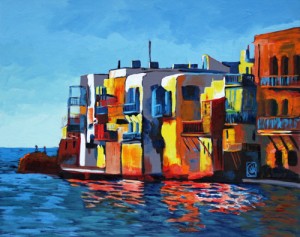Once I was in a choir where the director taught us how to hit the high notes. She said if you strain to slide up toward the high note, you’ll always be flat. To hit the right pitch, imagine that you’re on a path in the jungle. A wild beast jumps out of the shadows and scares you. You let out a screech and jump for the tree branch overhead. With enough momentum, you may miss the branch, but you can catch it on the way down. So aim above the note you want and land solidly on it from above.
Color in painting works the same way. The pure hues of Fauvism bring in the wild beast energy, but leave you with options. If you decide to reduce the intensity, you can do some mixing and blending. On the other hand, if you start out mixing low intensity colors, it’s very difficult to pump up the color excitement.
Do you want more color excitement in your painting? Do you appreciate brilliant color in paintings that you observe or collect, but want to know more about how it is created? If so, try this experiment….choose a pair of complementary colors (opposites on the color wheel), for example orange and blue. Paint some simple paintings or find photos of art with a lot of blue and orange. Find a level of intensity that is “too much”. Then find one that is “just right”. What makes the difference? Does the “just right” color combination add in some lower intensity version of the colors? Does it include other pairs of complements, or some grays? Is “just right” accurate natural color, or do you like some exaggeration? Do you find your self appreciating the art for the color combination as well as for the subject matter? How does this affect your painting or collecting?
Please post comments about your observations.

Hannah
9 Oct 2013What is this piece called and who is the artist?
lucindahowe
9 Oct 2013This piece is Little Venice Sunset, 16×20″, Acrylic, ©2006 by Lucinda Howe